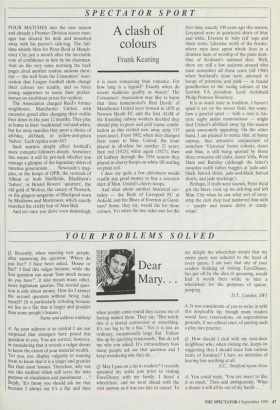SPECTATOR SPORT
A clash of colours
Frank Keating
FOUR MATCHES into the new season and already a Premier Division soccer man- ager has cleared his desk and mooched away with his parrot's sick-bag. The full- time whistle blew for Peter Reid at Manch- ester City just a month after the inevitable vote of confidence in him by his chairman. And on the very same morning the back pages aired another routine autumn chest- nut — the wail from the Consumers' Asso- ciation that League football clubs change their colours too readily, and so force young supporters to waste their pocket- money on exorbitant prices for replicas.
The Association charged Reid's former neighbours, Manchester United, with excessive greed after changing their outfits four times in the past 12 months. They play at home in their 'traditional' red-and-white, but for away matches they sport a choice of all-blue, all-black, or yellow-and-green `halves'. Each replica costs £47.
Such matters deeply affect football's more romantic followers deeply. Anywhere this winter it will be pot-luck whether you manage a glimpse of the legendary shirts of timeless generations . . . Newcastle's mag- pies, or the hoops of QPR, the verticals of Albion or both Sheffields, Blackburn's `halves', or Bristol Rovers"quarters', the old gold of Wolves, the canary of Norwich, or the gingery-tangerine of Blackpool worn by Matthews and Mortenson, which exactly matched the crickly hair of Alan Ball.
And yet once you delve even skimmingly
it is more romancing than romance. For how long is a legend? Exactly when do recent traditions qualify as history? The Consumers' Association may like to know that 'time immemorial's Red Devils' of Manchester United were formed in 1878 as Newton Heath FC and the first AGM of the founding railway workers decided they should play in green and gold (same combi- nation as this reviled new away strip 115 years later). From 1902, when they changed their name to Man. United, the team played in all-white for another 21 years; then red (1923); white again (1927); then till halfway through the 1934 season they played in cherry-hoops-on-white till settling on plain red.
I dare say quite a few old-timers would readily pay good money to buy a souvenir shirt of Man. United's cherry hoops.
And what about another historical cer- tainty — the Reds of Liverpool FC at Anfield, and the Blues of Everton at Good- ison? Some, they say, would die for those colours. Yet when the two sides met for the
first time, exactly 100 years ago this season, Liverpool were in quartered shirts of blue and white, Everton in 'ruby red' tops and black trews. Likewise north of the border, where men have spent whole lives in a drunken haze of worship of the plain dark- blue of Scotland's national shirt. Well, there are still a few ancients around who must remember all those years (till 1900) when Scotland's team were adorned in hoops of primrose and pink — in feudal genuflection to the racing colours of the Scottish FA president, Lord Archibald Philip Primrose Rosebery.
It is as much taste as tradition. I haven't spied it yet on the soccer field, but some- how a general sport — with a nod to his- toric rugby union connotations — might find United's all-black away rig this season quite awesomely appealing. On the other hand, I am pleased to notice that, at home anyway, that attractive conjunction of somehow 'Victorian' footer colours, claret and blue, is still being sported by those three evocative old clubs, Aston Villa, West Ham and Burnley (although the latter's awayday outfit rather boggles at `jade-and- black halved shirts, jade-and-black halved shorts, and jade stockings').
Perhaps, if truth were known, Peter Reid got the blues, took up his sick-bag and left Man. City when he saw what sort of away- strip the club shop had lumbered him with — 'purple and mauve shirts in candy- stripe'.


















































 Previous page
Previous page